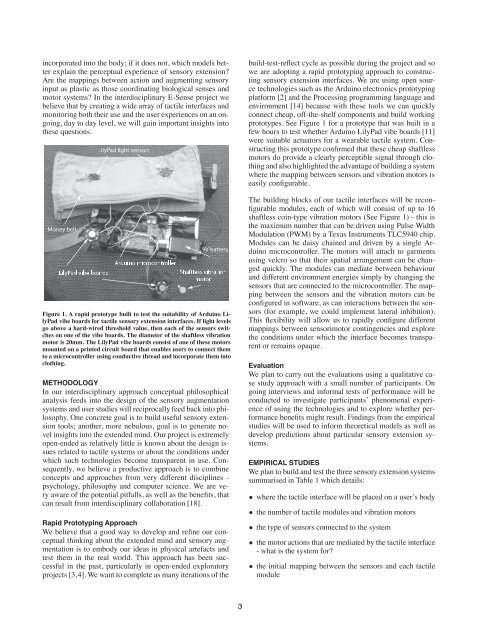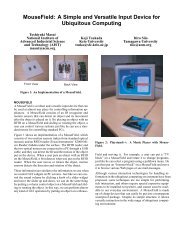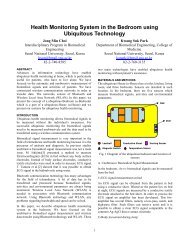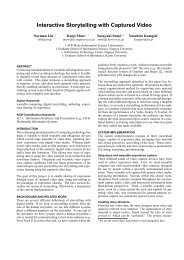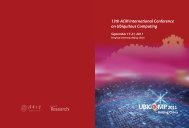Workshops - UbiComp
Workshops - UbiComp
Workshops - UbiComp
- No tags were found...
You also want an ePaper? Increase the reach of your titles
YUMPU automatically turns print PDFs into web optimized ePapers that Google loves.
incorporated into the body; if it does not, which models betterexplain the perceptual experience of sensory extension?Are the mappings between action and augmenting sensoryinput as plastic as those coordinating biological senses andmotor systems? In the interdisciplinary E-Sense project webelieve that by creating a wide array of tactile interfaces andmonitoring both their use and the user experiences on an ongoing,day to day level, we will gain important insights intothese questions.Figure 1. A rapid prototype built to test the suitability of Arduino LilyPadvibe boards for tactile sensory extension interfaces. If light levelsgo above a hard-wired threshold value, then each of the sensors switcheson one of the vibe boards. The diameter of the shaftless vibrationmotor is 20mm. The LilyPad vibe boards consist of one of these motorsmounted on a printed circuit board that enables users to connect themto a microcontroller using conductive thread and incorporate them intoclothing.METHODOLOGYIn our interdisciplinary approach conceptual philosophicalanalysis feeds into the design of the sensory augmentationsystems and user studies will reciprocally feed back into philosophy.One concrete goal is to build useful sensory extensiontools; another, more nebulous, goal is to generate novelinsights into the extended mind. Our project is extremelyopen-ended as relatively little is known about the design issuesrelated to tactile systems or about the conditions underwhich such technologies become transparent in use. Consequently,we believe a productive approach is to combineconcepts and approaches from very different disciplines -psychology, philosophy and computer science. We are veryaware of the potential pitfalls, as well as the , thatcan result from interdisciplinary collaboration [18].Rapid Prototyping ApproachWe believe that a good way to develop and e our conceptualthinking about the extended mind and sensory augmentationis to embody our ideas in physical artefacts andtest them in the real world. This approach has been successfulin the past, particularly in open-ended exploratoryprojects [3,4]. We want to complete as many iterations of thebt cycle as possible during the project and sowe are adopting a rapid prototyping approach to constructingsensory extension interfaces. We are using open sourcetechnologies such as the Arduino electronics prototypingplatform [2] and the Processing programming language andenvironment [14] because with these tools we can quicklyconnect cheap, off-the-shelf components and build workingprototypes. See Figure 1 for a prototype that was built in afew hours to test whether Arduino LilyPad vibe boards [11]were suitable actuators for a wearable tactile system. Constructingthis prototype d that these cheap shaftlessmotors do provide a clearly perceptible signal through clothingand also highlighted the advantage of building a systemwhere the mapping between sensors and vibration motors iseasily The building blocks of our tactile interfaces will be recon-e modules, each of which will consist of up to 16shaftless coin-type vibration motors (See Figure 1) - this isthe maximum number that can be driven using Pulse WidthModulation (PWM) by a Texas Instruments TLC5940 chip.Modules can be daisy chained and driven by a single Arduinomicrocontroller. The motors will attach to garmentsusing velcro so that their spatial arrangement can be changedquickly. The modules can mediate between behaviourand different environment energies simply by changing thesensors that are connected to the microcontroller. The mappingbetween the sensors and the vibration motors can bed in software, as can interactions between the sensors(for example, we could implement lateral inhibition).This exibility will allow us to rapidly e differentmappings between sensorimotor contingencies and explorethe conditions under which the interface becomes transparentor remains opaque.EvaluationWe plan to carry out the evaluations using a qualitative casestudy approach with a small number of participants. Ongoing interviews and informal tests of performance will beconducted to investigate participants’ phenomenal experienceof using the technologies and to explore whether performances might result. Findings from the empiricalstudies will be used to inform theoretical models as well asdevelop predictions about particular sensory extension systems.EMPIRICAL STUDIESWe plan to build and test the three sensory extension systemssummarised in Table 1 which details: where the tactile interface will be placed on a user’s body the number of tactile modules and vibration motors the type of sensors connected to the system the motor actions that are mediated by the tactile interface- what is the system for? the initial mapping between the sensors and each tactilemodule3


